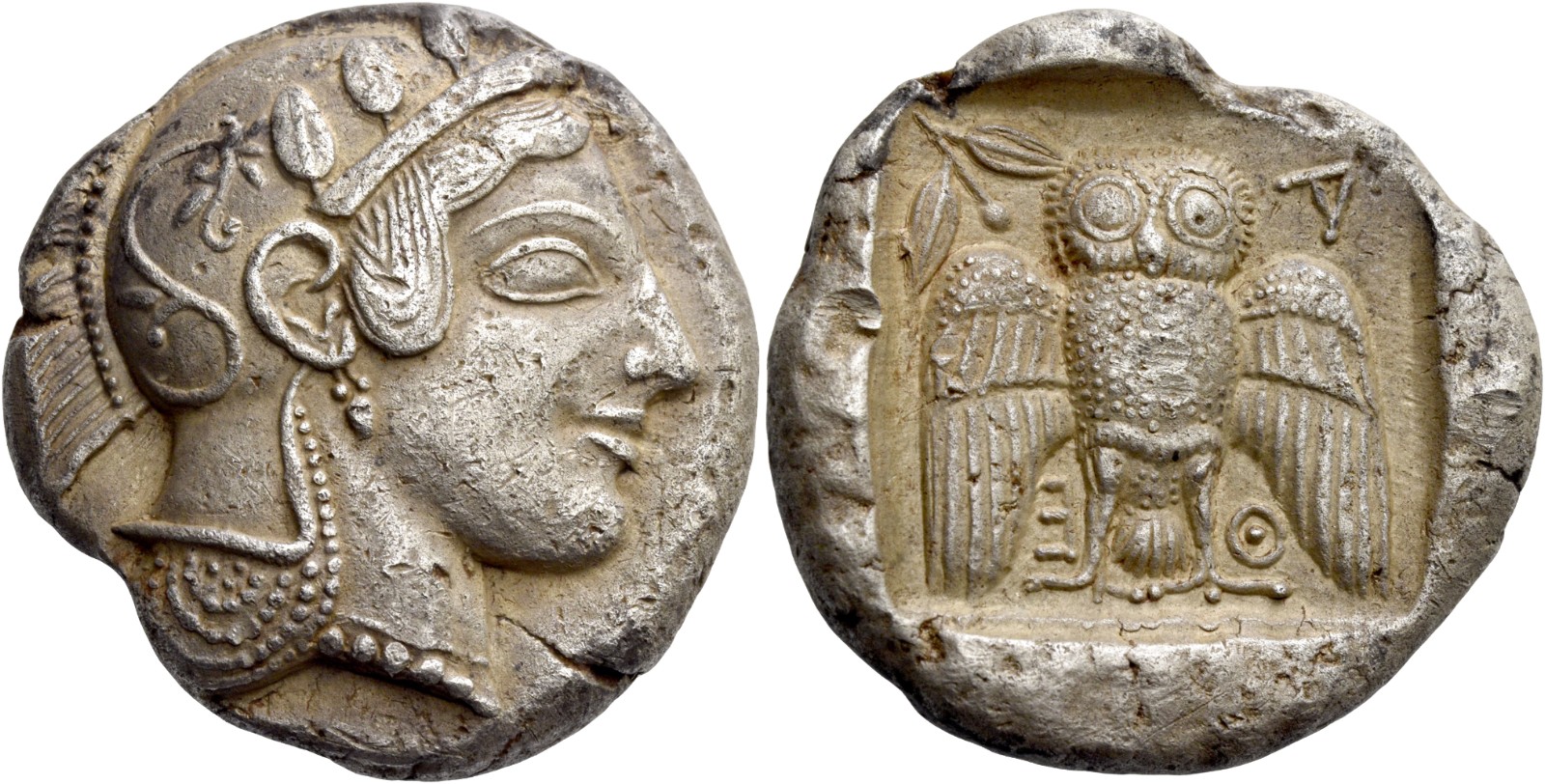Athens, silver, decadrachms (467-465 BCE-) Fischer-Bossert
From SILVER
467 BCE - 465 BCE Silver 20,320 kg
Description
| ObverseInscription or printing placed on the obverse.: | Head of Athena r., wearing crested helmet, earring and necklace, bowl ornamented with spiral and three olive leaves |
| ReverseInscription or printing placed on the reverse.: | A – Θ – E (Greek).Owl standing facing, with spread wings, in upper l. field, olive sprig with two leaves and berry. The whole within incuse square |
Mint and issuing power
| MintIdentifies the place of manufacture or issue of a numismatic object.: | Athens | Ancient regionAncient region.: | Attica | Modern countryModern country: Greece | AuthorityIdentifies the issuing power. The authority can be "pretended" when the name or the portrait of X is on the coin but he/she was not the issuing power. It can also be "uncertain" when there is no mention of X on the coin but he/she was the issuing power according to the historical sources: |
Chronology
| FromIdentifies the initial date in a range assigned in a numismatic context. | 467 BCE | toIdentifies the final date in a range assigned in a numismatic context.. | 465 BCE | PeriodTime period of the numismatic object.: Classical 480-323 BC |
Physical description
| MetalThe physical material (usually metal) from which an object is made.: | Silver |
Median weightMedian of the weights of numismatic objects (in grams). in grams | 42.60 | DenominationTerm indicating the value of a numismatic object. Examples: tetradrachm, chalkous, denarius.: | decadrachm |
StandardStandard.: | Attic |
Image

AC192 Athens decadrachm.jpg [1]
References
| Die study referencePublication of the study: | Fischer-Bossert 20081Fischer-Bossert 2008, Fischer-Bossert 20092Fischer-Bossert 2009, Starr 19703Starr 1970 | ||
| Coin series referenceReference to coin series study: | Sear I4Sear I, n° 2516, RQEMAC5RQEMAC, n° 192, HGC 46HGC 4, n° 1585 | ||
| Coin series web referenceCoin series web references: | |||
Obverse dies distribution
| FrequencyFrequency of specimen in distribution. ᵖ | Number of obversesNumber of obverse dies. ᵖ (o) | % (o) | Number of coinsNumber of coins. (n) | % (n) | Die nameName(s) of the die(s). |
| 1 | 5 | 29.41 | 5 | 11.9 | 1, 2, 5, 6, 12 |
| 2 | 4 | 23.53 | 8 | 19.05 | 9, 11, 14, 15 |
| 3 | 5 | 29.41 | 15 | 35.71 | 3, 8, 10, 13, 16 |
| 4 | 1 | 5.88 | 4 | 9.52 | 7 |
| 5 | 2 | 11.76 | 10 | 23.81 | 4, 17 |
| Total | 17 of 17 | 99.99 | 42 of 42 | 99.99 |
Reverse dies distribution
no distribution is available
Quantification
| Number of obversesNumber of obverse dies. ᵖ (o) | 17 | Number of singletons (o1)The number of singleton coins. ᵖ | 5 |
| Number of reverse diesNumber of reverse dies. (r) | 28 | Number of coinsNumber of coins. (n) | 42 |
| Coins per obverse dieNumber of coins per obverse die. (n/o) | 2.47 | Coins per reverse dieNumber of coins per reverse die. (n/r) | 1.5 |
| Reverse per obverse ratioRatio of obverse dies divided by reverse dies. (r/o) | 1.65 | Percentage of singletons (o1)number of coins (n) divided by the number of singletons (o1) ᵖ | 29.41 % |
| Original number of dies (O) (Carter 1983 formula)The estimation of the number of coins according to Carter 1983 ᵖ | 23.85 | Coins struck if 20,000 as average productivity per dieCoins made if the average productivity for obverses (according to Carter) is 20,000. ᵖ | 477,000 |
| Original number of dies (O) (Esty 2011 formula)The estimation of the number of coins according to the singleton formula in Esty 2011 ᵖ (O) | 28.56 | Survival rate if 20,000 as average productivity per dieSurvival rate if average productivity is 20,000. ᵖ | 0.00009 |
| Coverage (o = % of O) (Esty 1984 formula)Esty 1984 - coverage (% of O) ᵖ (o = % of O) | 88.1% | Die productivity if survival rate 1/2,000Average productivity if survival rate is 1/2,000. ᵖ | 3,522.01 |
| Weight of silver (in kg) if 20,000 coins per die (O = Carter formula)Carter 1983 * Median weight * 20000 (*10 if gold or electrum) ᵖ | 20,320 kg <br /> 20,320 kg | Die productivity if survival rate 1/5,000Average productivity if survival rate is 1/5,000. ᵖ | 8,805.03 |
Remarks
References
- ^ Fischer-Bossert, Wolfgang (2008), The Athenian Decadrachm, Numismatic Notes and Monographs 168, New York, x, 94 p., 41 pl.
- ^ Fischer-Bossert (2009), "More Athenian decadrachms", Schweizerische Numismatische Rundschau, 88, p. 117-126.
- ^ Starr, Chester G. (1970), Athenian Coinage 480-449 B.C., Oxford, 97 p., 26 pl.
- ^ Sear, David R. (1978), Greek coins and their values. Vol. I, Europe, London, xl, 316 p.
- ^ Callataÿ, François de (2003), Recueil quantitatif des émissions monétaires archaïques et classiques, Numismatique Romaine, Wetteren, VII + 267 p.
- ^ Hoover, Oliver D. (2014), Handbook of Greek Coinage Series 4. Northern and Central Greece : Achaia Phthiotis, Ainis, Magnesia, Malis, Oita, Perrhaibia, Thessaly, Akarnania, Aitolia, Lokris, Phokis, Boiotia, Euboia, Attica, Megaris and Corinthia, sixth to first centuries BC, Lancaster, lxxi, 563 p.